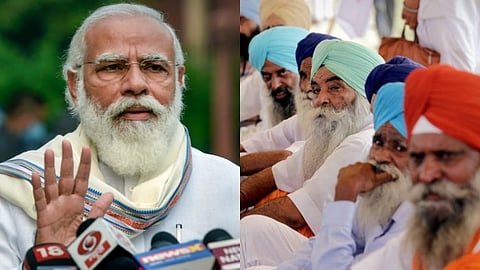

Narendra Modi must carry out serious talks with farmers to end impasse, writes KALYANI SHANKAR.
———-
The continuing protests by the farming community for the past 20 days might as well be one of the biggest challenges of the Modi government. Though the government is seized of the issues, the confrontation still continues.
Perhaps it is time to look back and see how India became self-sufficient in food grains in the late sixties and early seventies.
Former Prime Ministers Lal Bahadur Shastri and his successor Indira Gandhi had been responsible for the Green Revolution.
“US President Lyndon Johnson's food politics was a puzzle even to his officials. However, it had a happy ending because, by the time Johnson left, India had experienced a Green Revolution.
The origin of the food crisis began in the last year of Nehru era, as the first two five-year plans did not pay adequate attention to agriculture. That summer riots started in food shortage states.
It was then that India resorted to PL-480 food grains as part of the US policy 'Food for Peace.'
Soon, India faced a crisis in supply of food grains from the United States. US President Lyndon Johnson's food politics was a puzzle even to his officials. However, it had a happy ending because, by the time Johnson left, India had experienced a Green Revolution.
Prime Minister Shastri had in his very first month in 1964 indicated a shift of emphasis from heavy to light industry, and towards consumer goods and agriculture. He asked his agriculture minister C. Subramaniam to chalk out a new strategy to increase production.
By giving the slogan 'Jai Jawan, Jai Kisan', Shastri inspired both farmers as well as farm scientists sowing the seeds of the Green Revolution.
Meanwhile, within a few months into his second term, Johnson decided to take a tougher approach to India and Pakistan on food grains supply. At this time Johnson told his puzzled officials "I will take care of the problem." He waited till the last minute before he would personally authorize the shipments. American Ambassador to India Chester Bowels called the supply as "ship to mouth" program as it never went through the warehouses.
“She hit back on Johnson and signed a declaration calling for an end to "imperialist aggression" against the Vietnamese people. Lyndon Johnson's response was swift. Shipments to India slowed down.
After Indira Gandhi took over as the Prime Minister in January 1966, she continued the focus on agriculture. One of the first things Indira sought from Johnson during her first visit to Washington as Prime Minister in March 1966 was food aid. Though Johnson was bowled over by her charm, he made it clear that the two primary conditions for US help -self-help and more focus on agriculture- were necessary.
Things began to change as India ushered in an era of expansion in the farm sector, which started with the introduction of high-yielding varieties of wheat in the late 1960s.
With all the push for agriculture coupled with the efforts of leading scientists like Dr. M. S. Swaminathan, the Indian farm sector slowly began to improve yields and got closer to solving the chronic food shortages in the country.
Indira Gandhi made the Green Revolution a key government priority and along with the new hybrid seeds, initiated state subsidies, the provision of electrical power, water, fertilizers, and credit to farmers. Agricultural income was not taxable.
“Meanwhile, government investment in agriculture also rose sharply.
The result was that India became self-sufficient in food – a heartfelt aim for Indira after Johnson's erratic and condition-laden food aid. At one time when she hung up after talking to Johnson, she is reported to have said angrily, "I don't ever want us to have to beg for food again."
She hit back on Johnson and signed a declaration calling for an end to "imperialist aggression" against the Vietnamese people. Lyndon Johnson's response was swift. Shipments to India slowed down.
But later, once Johnson was satisfied that the Green revolution was becoming effective, he became liberal and tried to get the support of other countries to share the burden with the US. World Bank also stated a consortium for food supply.
Today, we have achieved self-sufficiency as food production has gone up from less than 50 million tonnes in 1947 to 250 million tonnes. India also has the largest irrigated land in the world.
“Over the years successive governments have thrown sops at farmers, including large subsidies on power or fuel, but there have been little sustained or strategic expenditures to modernize the sector.
Meanwhile, government investment in agriculture also rose sharply.
Besides, public investment, institutional credit, remunerative prices, and the availability of new technology at low prices were also made available. By the eighties, not only was India self-sufficient but was also exporting food to pay off its loans or loaning it to food-deficit countries.
Over the years successive governments have thrown sops at farmers, including large subsidies on power or fuel, but there have been little sustained or strategic expenditures to modernize the sector.
Prime Minister Narendra Modi also came up with several schemes for farmers and is now talking of an Evergreen Revolution in the farming sector, a call for agriculture in all seasons. Evergreen is a plant that keeps its leaves in all seasons.
However, the three new farm laws have created apprehensions among the farmers.
There is lack of consultations and a trust deficit and the opposition parties too have used the opportunity to attack the government. The government as well as farmers should adopt a give and take attitude and resolve the issue rather than prolonging it. (IPA)
(Kalyani Shankar is a senior journalist and political commentator. Views are personal.)